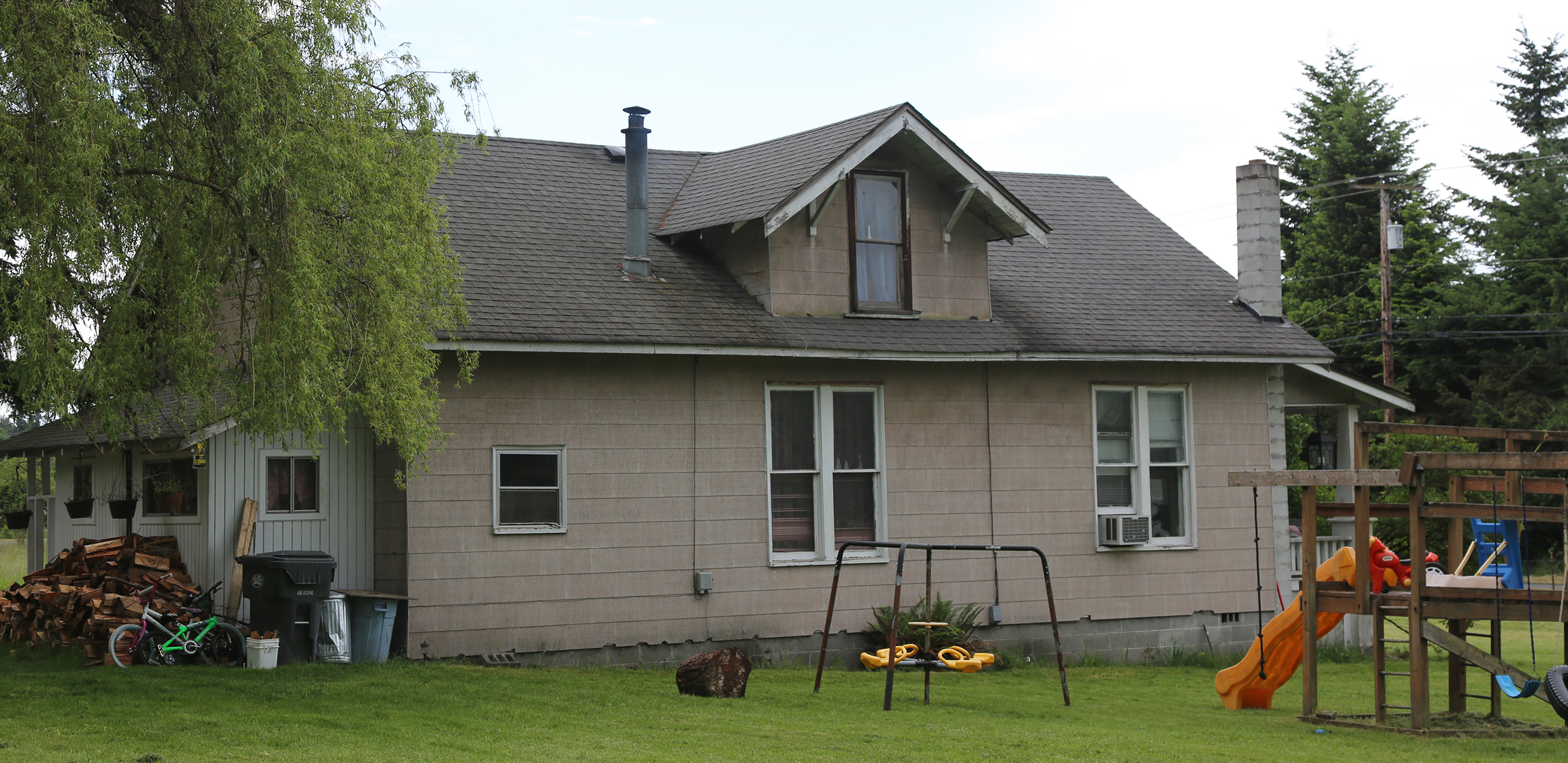
Story by matthew johnson and justin milner
Photos and video by Matthew Johnson and Adrianne Haney

Story by matthew johnson and justin milner
Photos and video by Matthew Johnson and Adrianne Haney
Top left: The hallways of McCarver Elementary. Top right: The home of Olson’s mother, where Olson and her children stayed after being evicted in 2012. Weeks later she moved into an apartment for recovering addicts and her elder daughter began kindergarten at McCarver Elementary School. Bottom left: Olson listens attentively at her high school graduation rehearsal. Olson is the first in her immediate family to graduate from high school. Bottom right: Olson’s daughters, ages 4 (left) and 8 (right), have made great educational strides since becoming a part of the McCarver Elementary School Special Housing Program.
Chrystal Olson stood outside her Parkland, Washington, apartment on a winter day in 2012 as the few belongings she owned were removed. In the unsettling moments of eviction, she looked at her children’s faces and saw their confusion and pain.
She had been here before, and it was a place she swore to never let herself or her children come to again. If she could just get a little help.
Olson had used methamphetamines off and on for 16 years, and her children had paid a high price for it. In addition to having an unaccountable mother, the children had an abusive father, lived with little in the way of food, clothing, and shoes, and frequently moved from place to place.
But when the family moved to their new neighborhood, and Olson’s oldest daughter enrolled at McCarver Elementary School, an innovative program presented the opportunity to heal this family.
McCarver serves the Hilltop, a diverse neighborhood in transition from struggles with poverty, drugs, and violence. In decades past, Hilltop was known for its integrated magnet schools and community engagement. Since that time, McCarver has seen unsteady days, a stark contrast from earlier periods of stability.
Like Olson’s children, many of McCarver’s students move residences each year. In 2006, McCarver’s student turnover rate was 179 percent. In other words, each classroom desk had almost three different assigned students sit in it over the course of the school year.
In 2006, McCarver Elementary in Tacoma, WA, experienced a 179% turnover rate. What does this mean? How is that possible?
Though the seats available in a classroom are fixed, more than one child occupies each seat throughout the year.
Given a classroom with 20 seats available, students would come and go until 56 children have been in the class— almost three times the original class size.

McCarver is not alone in Washington when it comes to facing high student turnover rates. Nor is it unique nationally; an increasing number of schools in other parts of the country have hypermobile populations.
About 1.3 million public school students were homeless during the 2012–13 school year, both an 8 percent increase from the previous year and a new record high, according to the National Center for Homeless Education.
Homelessness often leads to frequent student mobility, and when schools have high student turnover, neither students nor teachers can do their best.
Hypermobile students experience difficulties with classroom participation and academics, sometimes leading to repeating grades or failing to complete school. What’s worse, new students entering schools throughout the year can disrupt whole classrooms and lead to worse academic outcomes for all students, not just those who move. Urban Institute researchers point to growing evidence of the broad negative effects that such instability can have on child well-being.
For teachers, seeing their students come and go in a matter of weeks, not years, robs them of the chance to get to know the kids, evaluate their strengths and weaknesses over time, and adjust their lesson plans to help them improve in their areas of need.
It’s a steep uphill climb for all parties, to say the least.
In Tacoma, where students and educators had faced these problems for some time, enough became enough. Something had to change.
Student art in McCarver Elementary spotlights student self-portraits and goals.
By 2009, troubled schools were an obvious symptom stemming from persistent problems on the Hilltop. As poverty, housing instability, hypermobility, and homelessness combined to undermine efforts in classrooms, the Tacoma Housing Authority’s waiting lists for housing vouchers and public housing units grew as long as seven years with no relief in sight.
Like many housing authorities around the country, Tacoma typically uses vouchers funded by the Department of Housing and Urban Development (HUD) to help low-income families, including those in the midst of, or facing, homelessness.
Though families receiving vouchers may experience more stability and can ideally advance their long-term prospects, they may also use their vouchers to move away from their original neighborhoods. The program allows beneficiaries to move to any neighborhood where they can find affordable, voucher-accepting housing. But the communities that voucher holders may leave behind, like Hilltop, don’t see any improvements when this happens — and neither do their schools.
At this time, Michael Mirra, the executive director of the Tacoma Housing Authority, began to tinker with an idea that, if successful, could accomplish more than just housing poor families. Perhaps the same dollars spent on housing assistance could simultaneously boost low-income children’s academic performance, help their school succeed, and transform a neighborhood.
“The data is pretty clear that student turnover is destructive to school outcomes for the children who come and go, and for their classmates who have to sit there and watch it happen,” said Mirra. “Children who grow up in deep poverty bring challenges to the schoolhouse door that the best-trained teacher in the fanciest classroom cannot address on their own. We start[ed] this experiment with a surmise that a housing authority is situated to be influential.”
To do this, the authority would have to broaden the scope of its business in the Hilltop community. Doing that required strategic partnerships with the Tacoma School District and critical neighborhood stakeholders.
“It really became evident to us that no one [thing]—the counseling, and employment support, and education, and the extended learning opportunities for children—was really going to make the difference, even something as big as housing,” said Michael Power, the Tacoma Housing Authority’s manager of educational programs during the McCarver pilot’s first three years.
Left: Student art lines the lockered walls of McCarver Elementary. Right: Outside the front doors of McCarver Elementary, a school bus waits to shuttle students home.
“It was the combination of those things that was going to make a difference,” he added. “So that these children would not become our clients as adults, would not be in need of public support, and would be independent, constructive citizens.”
The good news was that the school district was on board. It viewed the partnership as an opportunity to support struggling families more comprehensively.
“We have kids for six to eight hours a day,” said Christine Hinds, director of elementary education for the Tacoma School District. “That's all we can control. This is an opportunity for us as educators to move beyond just those six or eight hours. It takes more than any single entity to support some of our families in our community that have a lot of needs.”
Over the next year and a half, Tacoma’s housing authority and school district carefully designed a pilot program that aimed to develop an alternative model to conventional housing and education programs. What emerged from the incubation period came to be known as the McCarver Elementary School Special Housing Program.
The pilot offered 50 homeless families with a child enrolled in kindergarten, first, or second grade at McCarver five years of rental assistance. In the first year, the family paid just $25 a month in rent. The second year the family paid 20 percent of the rent, with an additional 20 percent added each successive year.
In return, the families agreed to meet five expectations:
Some of these programmatic elements — such as time-limiting the vouchers, asking parents to stay tied to a school, and adding behavioral requirements — are potentially controversial and require research into their effectiveness.
The McCarver program is just beginning its fourth year, and Mirra is awaiting the third independent evaluation. The first two appraisals showed promise, and if the third comes back positive, Mirra and his colleagues will begin to discuss extending the program at McCarver and possibly expanding to other schools in need. Tacoma’s housing authority and school district will determine where things go from here, but many around the country are waiting to see the program’s broader effects.

View of the East 11th Street Bridge from downtown Tacoma.
Looking at the big picture, the McCarver program represents a first step down an innovative path. More and more, policymakers, researchers, and philanthropists are becoming interested in using housing as a platform to deliver services and supports to low-income families, beyond just the provision of safe and affordable places to live.
“Housing providers can leverage this platform by working with external partners to connect housing with educational opportunities, better health access, and greater economic prospects,” said Erika Poethig, Institute fellow at the Urban Institute and former acting assistant secretary for policy development and research at HUD. “Using research as a starting point to inform strategies and interventions, partnerships between housing providers and other systems, like schools, have real potential to drive policy that looks at family needs holistically and comprehensively.”
For some time, researchers have pointed to the fact that simply providing housing can significantly stabilize the lives of low-income families by decreasing the frequency of moves and rates of homelessness, both of which correlate with negative educational outcomes.
In addition, recent research from John Hopkins Professor Sandra Newman shows that affordable housing often leads to increased funding in critical investments, such as child care, learning materials, activities, and health care. All these elements correlate positively with educational outcomes.
Pediatrician and Housing Researcher Megan Sandel even considers housing a “vaccine” that lowers the risks of bad health and poor educational attainment.
So if vaccine-like benefits can result from simply providing affordable housing, what can happen when other critical agencies and service providers integrate and coordinate their efforts?
The interest in collaboration stems from the recognition that multiple public systems are simultaneously working with the same populations toward shared goals. This interest has played out locally in Tacoma, but also nationally, in recent years.
Several recent high-profile federal programs encouraged agencies to collaborate to address low-income communities’ complex issues. Some important examples:
National organizations are also starting to look more closely at how to use housing as a platform for other family supports.
Urban Institute researchers are currently helping organizations representing public and nonprofit housing providers — such as the Council of Large Public Housing Authorities and Stewards of Affordable Housing for the Future — consider ways to collaborate and promote positive educational results for children.


At the heart of innovation is often a philanthropic community that sees value in supporting new ways to address public needs. In the case of partnerships between housing authorities and school systems, philanthropy is playing a pivotal role.
The John D. and Catherine T. MacArthur Foundation has long funded research that looks at the effects of housing policies on children.
“We want to help demonstrate how housing matters and identify ways that we can work together across policy or programmatic silos to achieve beneficial outcomes for the people and communities we all care about," said Ianna Kachoris, program officer at the MacArthur Foundation. “It is our aim to arm those who share our goal of a decent, stable, affordable home for all Americans with the best available evidence.”
Similarly, the Bill & Melinda Gates Foundation gave seed funding to the Tacoma Housing Authority so it could hire Michael Power as a staffer dedicated to strategizing about, and developing, educational partnerships.
“The McCarver project is just a great example of the ways that two systems that interact with the same families, with the same students, need to interact more purposefully, in a more aligned way, in order for us to have better results,” said Kollin Min, the Gates Foundation senior program officer who oversees investment in the McCarver program. “[That position] plays that important translational role between the two systems, so that the systems could speak better, could align their goals and perspectives better.”
The Gates Foundation has also committed to supporting similar positions in other public housing agencies around the Pacific Northwest, Min said.
But financial support and vision aren’t enough. Collaborations have the best chances for success when there is also political will and capital.
The McCarver program is exceptionally notable because it’s attracted the interest of Washington State lawmakers and policymakers from across the political spectrum.
Three legislators — Rep. Hans Zeiger (R) and senators Jeannie Darneille (D) and Bruce Dammeier (R) — sponsored companion bills that would encourage housing agency–school district partnerships around the state and use Washington’s grant programs to incentivize them.
“It’s a broader issue that needs to be tackled in a broad fashion,” said Rep. Jake Fey (D), the legislator who represents McCarver’s district. The program, he adds, should expand into a more concerted, holistic effort to address poverty from different angles.
The McCarver model represents just one approach to addressing some of the common housing and education challenges faced by low-income families. The partnership between the housing authority and the school, the structure of the rental assistance, and the incentives for school stability are all new approaches to complex problems.
Barbara Duffield, director of policy and programs at the National Association for the Education of Homeless Children and Youth, believes that it will be important to test out different models in the coming years. She says, “If the end goal is stability and success for families, and improving academic and other outcomes for kids, then there are different ways to get there, and the marriage of housing and education can be configured in different ways.”
It remains to be seen whether McCarver’s approach is the most effective way to address low-income families’ housing and educational issues, especially when considering that communities have different dynamics and needs.
Careful monitoring of both implementation and results will be needed to build confidence that the model can reliably improve outcomes for families in Tacoma and elsewhere.
In the long run, the ideal approach to building this confidence would be to randomly assign program benefits to one group of residents and compare their results to those experienced by a similar group assigned to status quo treatment. This approach could allow researchers to better isolate the effects of the program.
Meanwhile, as McCarver evolves and other new models are developed, several key questions will need attention:
Investments in both program development and research will be critical to learning more about what works for families struggling with housing and school instability. As philanthropy and policymakers look to make a difference for low-income families, this is an important space to explore.

Olson's daughters in their living room on the Hilltop in Tacoma, WA. The Hilltop is Tacoma's lowest-income neighborhood. The family has enjoyed greater stability by participating in the McCarver Elementary School Special Housing Program.
Chrystal Olson sat gleefully in the auditorium at Bates Technical College in downtown Tacoma on a June 2014 day. During a graduation rehearsal, a smile beamed across her face as she considered that in less than 24 hours she would become the first member of her immediate family to finish high school.
Meanwhile Olson’s elder daughter is blossoming at McCarver.
When she started as a kindergartener, she couldn’t read or write her own name, much less identify most letters in the alphabet. She subsequently received extra, sustained attention. Now as she enters second grade, she is a strong reader and a top-of-the-charts math student.
Olson is growing, too.
In addition to finishing her high school education, she has completed programs designed to help her with addiction, maximizing potential, and financial literacy. She’s also joined the PTA and volunteered as a recess monitor. And the whole family has joined a support group for victims of domestic violence.
“Before I was in the program, we struggled a lot financially,” said Olson. “But we have accomplished a lot in the last year. It's really a blessing for me and my children to be in this program.”
For Olson and other families in the McCarver program, the next few years will be especially important for learning if the model can succeed long term. Over that time, the rent support from the Tacoma Housing Authority will decrease, while the families’ responsibility to cover housing costs will increase.
Recent work by the Urban Institute’s Sue Popkin shows that families have a hard time stabilizing after losing voucher support. Because the McCarver design transitions families off vouchers, its ultimate success—and scalability—rests upon whether its families can establish regular sources of income.
Only time, evaluation, fine-tuning, and more gutsy innovative collaborations will truly tell. But so far it seems reasonable to think that success stories like Olson’s could be on the horizon for other cities and towns in the United States.